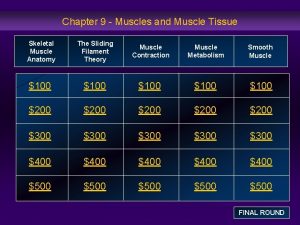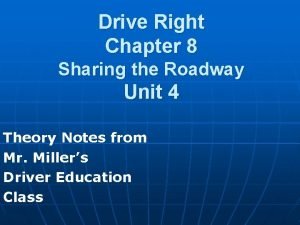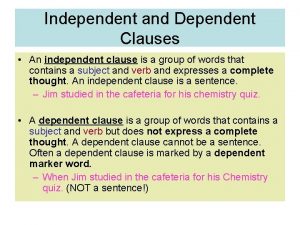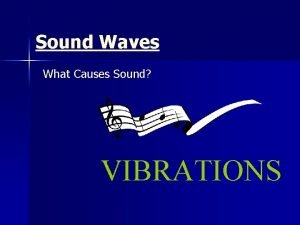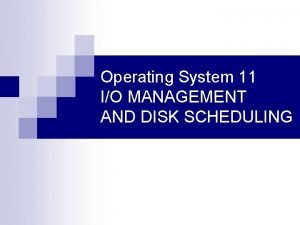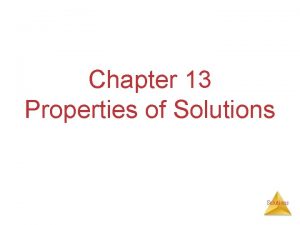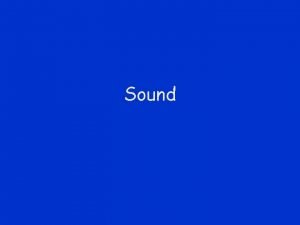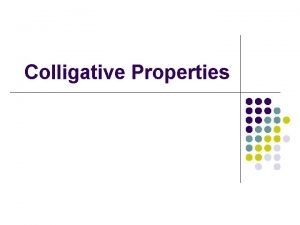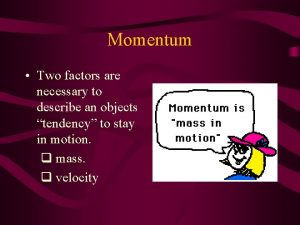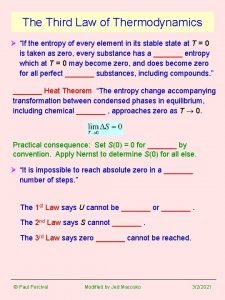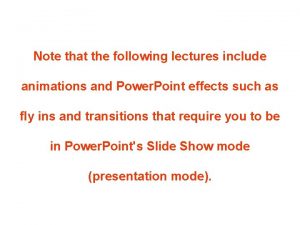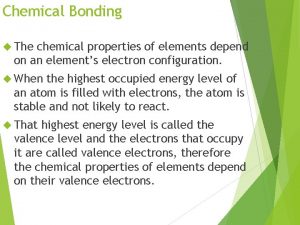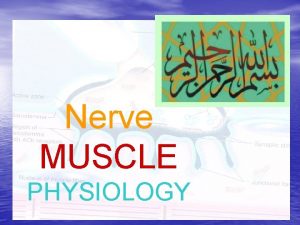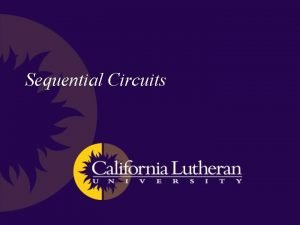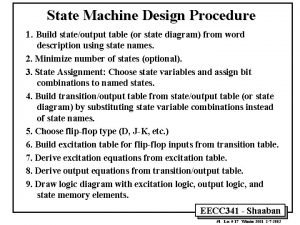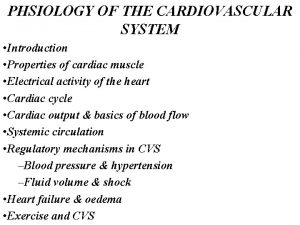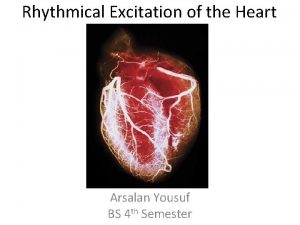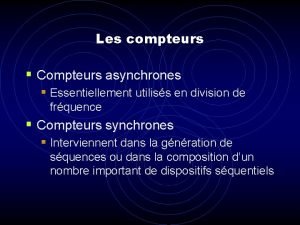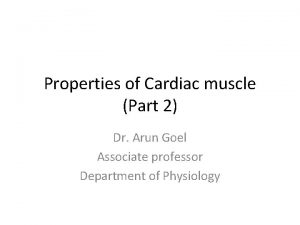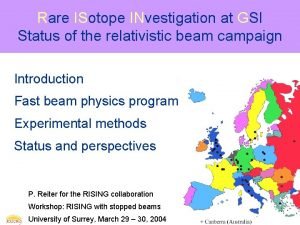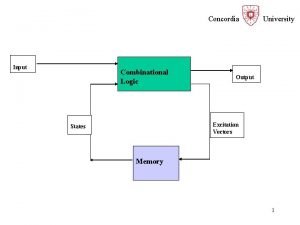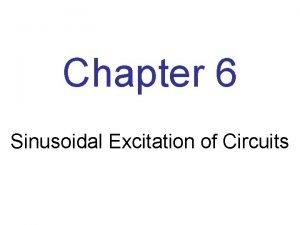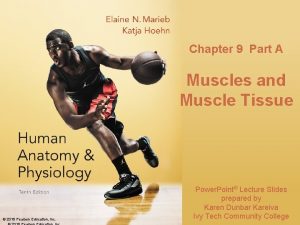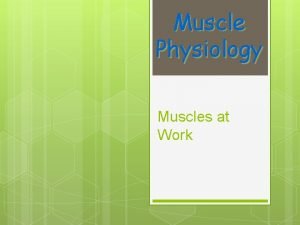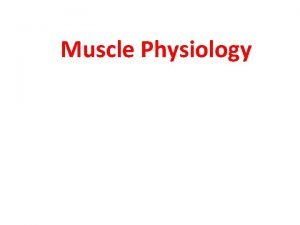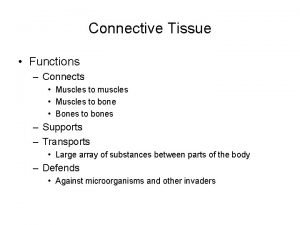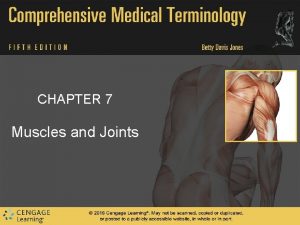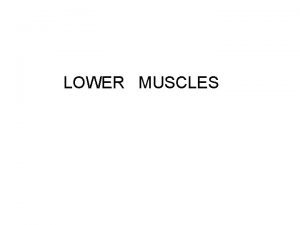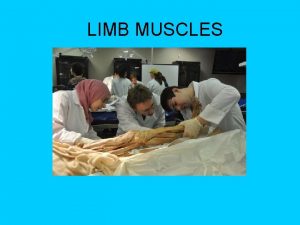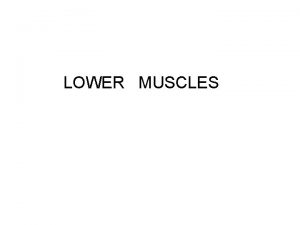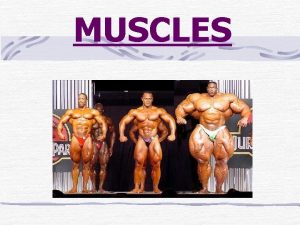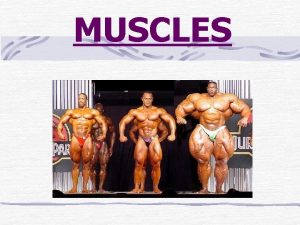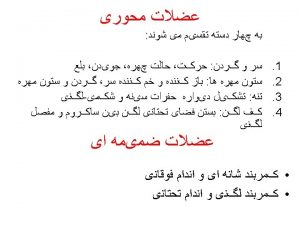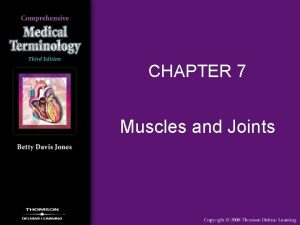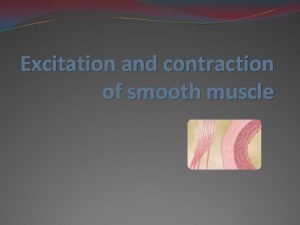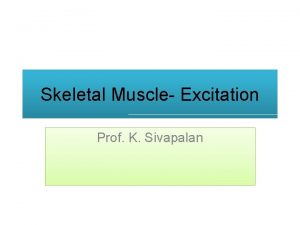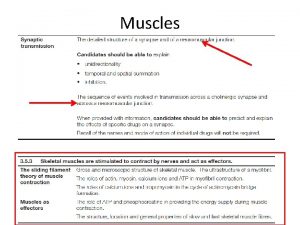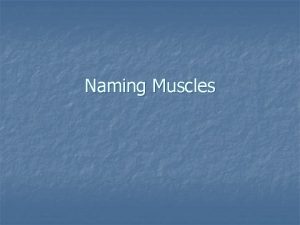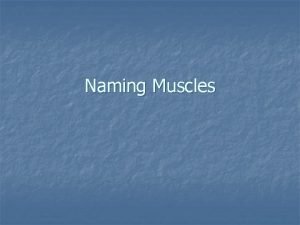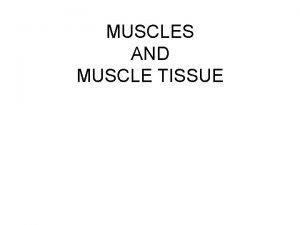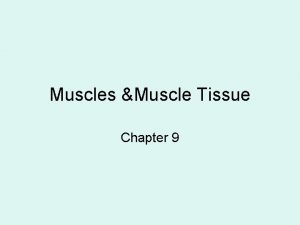Muscle excitation The excitation of muscles depend on



































- Slides: 35

Muscle excitation

• The excitation of muscles depend on the arrival of a stimulus to the muscle cell membrane to generate an excitation (action potential ) in the muscle membrane. • Some types of muscle also have the potential to be self excitable such as smooth and cardiac muscle ( cells of the conducting system )

• synapse : • Point of contact • is a site where information is transmitted from one cell to another. The information can be transmitted : electrically ) electrical synapse) Chemically (chemical synapse). • for example the synapse between nerve fiber and muscle fiber is the site of transmission of the neural order to the muscle to contract ) • Electrical synapses allow current to flow from one excitable cell to the next via low resistance pathways between the cells called gap junctions. • chemical synapses: there is a gap between the presynaptic cell membrane and the postsynaptic cell membrane, known as the synaptic cleft. Information is transmitted across the synaptic cleft via a neurotransmitter.



Electrical synapse

general sequence of events that occurs at chemical synapses : • . . change in membrane potential

The change in membrane potential on the postsynaptic cell membrane can be either excitatory or inhibitory, depending on the nature of the neurotransmitter released from the presynaptic nerve terminal: Excitatory: ACh, norepinephrine , epinephrine, dopamine, glutamate, Inhibitory glycine GABA) and serotonin. depolarization of the postsynaptic cell hyperpolarization of the postsynaptic cell


• A motor unit comprises a single motor neuron and the muscle fibers it innervates. • Motor units vary considerably in size: • A single motorneuron may activate a few muscle fibers or thousands of muscle fibers. • Predictably, small motor units are involved in fine motor activities (e. g. , facial expressions), and large motor units are involved in gross muscular activities (e. g. , quadriceps muscles used in running )


Muscles EXCITATION • Through Motor End Plate = neuromuscular junction. Ach esterase mitochondria






An action potential in the motor neuron produces an action potential in the muscle fibers it innervates by the following sequence of events • Action potentials. • presynaptic terminal is depolarized. • voltage-gated Ca channels. • Ca influx. • release of the neurotransmitter. • ACh binds to the α subunits of the nicotinic receptor. • Open ligand-gated ion channel. • permeability of the motor end plate to both Na +and K +increases.

• both Na +and K +flow down their respective electrochemical gradients • drive the motor end plate to its equilibrium potential • end plate potential (EPP) ü (The EPP is not an action potential , but it is simply a depolarization of the specialized motor end plate adjacent muscle fibers, which are depolarized to threshold and fire action potentials ü Although the motor end plate itself cannot fire action potentials, it depolarizes sufficiently to initiate the process in the neighboring "regular" muscle cells ü Ach degradation


Then NTs undergo degradation

Several agents interfere with normal activity at the neuromuscular junction,

Myasthenia Gravis DESCRIPTION OF CASE. An 18 -year-old college woman comes to the student health service complaining of progressive weakness. She reports that occasionally her eyelids "droop" and that she tires easily, even when completing ordinary daily tasks such as brushing her hair. She has fallen several times while climbing a flight of stairs. These symptoms improve with rest. The physician orders blood studies, which reveal elevated levels of antibodies to ACh receptors. Nerve stimulation studies show decreased responsiveness of skeletal muscle upon repeated stimulation of motoneurons. The woman is diagnosed with myasthenia gravis and is treated with the drug pyridostigmine. After treatment, she reports a return of muscle strength. EXPLANATION OF CASE ? ?


INTEGRATION OF SYNAPTIC INFORMATION Spatial Summation two or more presynaptic inputs arrive at a postsynaptic cell simultaneously. • If both inputs are excitatory, they will combine to produce greater depolarization than either input would produce separately. • If one input is excitatory and the other is inhibitory, they will cancel each other out Temporal Summation Temporal summation occurs when two presynaptic inputs arrive at the postsynaptic cell in rapid succession. Because the inputs overlap in time, they summate.

Facilitation, augmentation , posttetanic potentiation: are phenomena that may occur at synapses. In each instance, repeated stimulation causes the response of the postsynaptic cell to be greater than expected. The common underlying mechanism is believed to be an increased release of neurotransmitter into the synapse, possibly caused by accumulation of Ca +in the presynaptic terminal Synaptic fatigue may occur where repeated stimulation produces a smaller than expected response in the postsynaptic cell, possibly resulting from the depletion of neurotransmitter stores from the presynaptic terminal.

Excitation of cardiac muscle

Excitation of cardiac muscle



Excitation of smooth muscle

Excitation of smooth muscle can be stimulated to contract by multiple types of signals: 1. nervous signals 2. hormonal stimulation 3. stretch of the muscle, and in several other ways.

Membrane Potentials and Action Potentials in Smooth Muscle In the normal resting state, -50 to -60 millivolts The action potentials of visceral smooth muscle occur in forms: action potentials with plateaus spike potentials slow wave rythm

Action potential with a plateau, recorded from a smooth muscle fiber of the uterus. Typical smooth muscle action potential (spike potential) elicited by an external stimulus The importance of the plateau is that it can account for the prolonged contraction that occurs in some types of smooth muscle, such as the ureter, the uterus under some conditions, and certain types of vascular smooth muscle.

• Some smooth muscle is self-excitatory. • often associated with a basic slow wave rhythm of the membrane potential • The cause of the slow wave rhythm is unknown • The importance of the slow waves is that, when they are strong enough, they can initiate action potentials • Therefore, the slow waves are called pacemaker waves
 Muscles and muscle tissue chapter 9
Muscles and muscle tissue chapter 9 _____ muscles run across the cheek.
_____ muscles run across the cheek. Smooth muscle fusiform
Smooth muscle fusiform A motorcyclist's balance and stability depend on
A motorcyclist's balance and stability depend on 4 colligative properties
4 colligative properties Does morality depend on religion?
Does morality depend on religion? Independent conjunction
Independent conjunction The number of tankers needed for a fire will depend on the
The number of tankers needed for a fire will depend on the Colligative properties examples
Colligative properties examples What does the speed of sound depend on
What does the speed of sound depend on Codependency definition
Codependency definition De quoi dépend la couleur d'un objet
De quoi dépend la couleur d'un objet Cqlinq
Cqlinq When the process issues an io request
When the process issues an io request Colligative properties depend on
Colligative properties depend on What does the speed of sound depend on
What does the speed of sound depend on Science class five
Science class five Van’t hoff factor
Van’t hoff factor Two factors that affect momentum
Two factors that affect momentum Third law of thermodynamics is depend on
Third law of thermodynamics is depend on Why does a star's life expectancy depend on mass
Why does a star's life expectancy depend on mass What do the phases of the moon depend on
What do the phases of the moon depend on Physical properties of elements depend on
Physical properties of elements depend on Sarcoplasmic reticulum
Sarcoplasmic reticulum Jk ff excitation table
Jk ff excitation table Machine design procedure
Machine design procedure Orthorpnea
Orthorpnea Rhythmical excitation of the heart
Rhythmical excitation of the heart Compteur asynchrone modulo 11
Compteur asynchrone modulo 11 Cardiac excitation-contraction coupling
Cardiac excitation-contraction coupling Coulomb excitation
Coulomb excitation Synchronous counter design
Synchronous counter design Excitation
Excitation Sinusoidal excitation
Sinusoidal excitation Focus figure 9.2: excitation-contraction coupling
Focus figure 9.2: excitation-contraction coupling Coulomb excitation
Coulomb excitation
